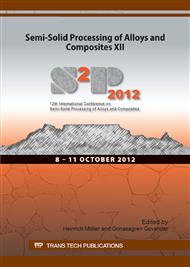p.293
p.299
p.305
p.311
p.317
p.323
p.329
p.335
p.341
The Rheological Behavior of HS6-5-2 Tool Steel for Non-Isothermal Processing
Abstract:
The rheological behavior of semi-solid tool steel is investigated using a conventional rheometer under cooling rate and shear rate. The processing of steels in semi-solid state is still at development stage due to the high processing temperature involved. The candidate grades of steel for thixoforming are high speed, high carbon, stainless steel and ductile iron. TheHS6-5-2 tool steel has a wide semi-solid range of over 200 C and the required spheroidal microstructure achieved by partial re-melting from as supplied state without any mechanical agitation, indicated the potential of this grade to be investigated in semi-solid processing. For non-isothermal processing an increase of solid fraction related to solidification due to thermal exchanges is observed. In the first series of experiment after melting the feed stock in an alumina cup, the alloy is sheared continuously by a rotating rod with a constant shear rate under three different cooling rates to the 55% corresponding liquid fraction. In the second series of experiment three different shear rates were applied under a constant cooling rate. The apparent viscosity of the slurry as a function of cooling rate and solid fraction is calculated from the applied torque to the outer cylinder. The results show that the slurry viscosity decreases with increasing shear rate and increases with increasing cooling rate and solid fraction. Additionally for a given solid fraction, shear thinning behavior is observed.
Info:
Periodical:
Pages:
317-322
Citation:
Online since:
October 2012
Authors:
Keywords:
Price:
Сopyright:
© 2013 Trans Tech Publications Ltd. All Rights Reserved
Share:
Citation:


